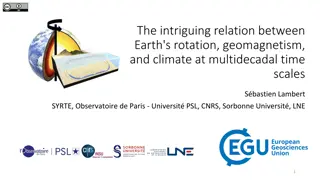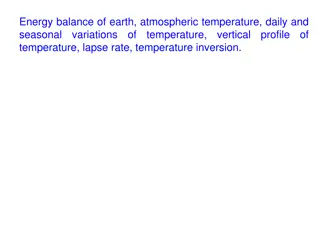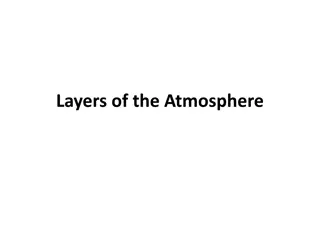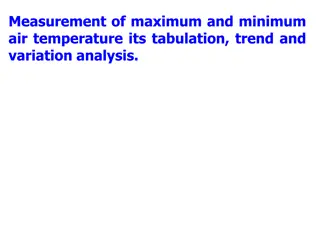Exploring Temperature Patterns on Earth: The Sun's Effect on Climate
Discover the fascinating relationship between the sun's effect on climate and temperature patterns on Earth at different latitudes and times of the year. This lesson delves into how temperatures vary with latitude from the equator, examining data for January and July to identify patterns and understand why some places are hotter than others. Explore the central question of why temperature differences exist on Earth and analyze bar graphs to interpret the data visually, looking for patterns related to both time of year and location in the Northern and Southern Hemispheres.
Download Presentation

Please find below an Image/Link to download the presentation.
The content on the website is provided AS IS for your information and personal use only. It may not be sold, licensed, or shared on other websites without obtaining consent from the author. Download presentation by click this link. If you encounter any issues during the download, it is possible that the publisher has removed the file from their server.
E N D
Presentation Transcript
THE SUNS EFFECT ON CLIMATE LESSON 1B What Temperature Patterns Can You Find on Earth at Different Times of the Year?
Focus Question from Last Time What temperature patterns can you find on Earth at different latitudes?
Temperature Patterns What temperature patterns did you observe in the data for January and July? How did you complete these sentences: The pattern I observe in January is ______. The pattern I observe in July is _________.
Key Science Idea Temperatures on Earth vary according to latitude, or how far a location is from the equator, both north and south.
Our Unit Central Question Why are some places on Earth hotter than others at different times of the year?
Lesson Focus Question What temperature patterns can you find on Earth at different times of the year?
The Equator Find the equator on your world maps and circle the labels that say Equator. What is the degree of latitude at the equator?
Bar Graph of January Temperatures What do the bars on the graph represent? How are the x- and y-axes labeled? Where does the latitude of the equator appear on the graph?
Looking for Patterns in the Data 1. Using the bar graphs, look for patterns in the temperature data for January and July. Can you find any patterns related to the month of the year (January versus July)? Can you identify any patterns related to the Northern and Southern Hemispheres? Write the patterns in your science notebooks. 2. Using all of your data sources, look for any patterns you might have missed and write them in your notebook.
What Patterns Did You Find? What temperature patterns did you find in your data sources related to latitude and time of year at various locations on Earth? Listen as your classmates share their ideas and reasoning. Think about whether you agree, disagree, want to add on, or have a question. Remember to communicate in scientific ways!
Temperature Patterns 1. What happens to the temperature if a location is closer to the equator? 2. What happens to the temperature if a location is farther away from the equator? 3. How do temperatures in various locations differ in January and July? 4. Are these temperature patterns the same in the Northern and Southern Hemispheres?
The Most Important Patterns Answer these questions in your science notebook: 1. What do you think is the most important pattern that describes temperatures on Earth at different locations (latitudes)? Why? 2. What do you think is the most important pattern that describes temperatures on Earth at different times of the year? Why? Be prepared to share your ideas!
What Patterns Do You Observe? Courtesy of Robert A. Rohde/ Wikimedia Commons
Lets Summarize! Key science ideas: 1. Temperatures on Earth are warmer closer to the equator. 2. Temperatures decrease as latitude increases. So as we move farther away from the equator, either north or south, temperatures will generally be cooler. 3. Temperatures vary at different latitudes at different times of the year.
Next Time Have you ever wondered why temperatures are higher closer to the equator and lower farther away from the equator? We ll explore this question tomorrow!
























